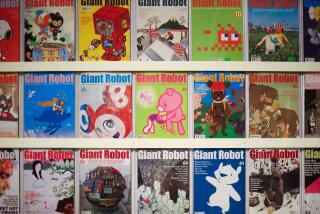Artist Uses Tiles to Entwine Past, Future
- Share via
CHULA VISTA — Toru Nakatani’s work of the past three years fills the Southwestern College Art Gallery with a spunky energy. His square tiles, bustling with color and line, repeat in staccato rhythms across the walls and form cubes, stacked and sculpted, on the floor.
Nakatani, a recent graduate of UC San Diego’s Master of Fine Arts program, evokes visions of the past and future in the designs he glazes on these tiles. His arrangements of them, too, range from the archaic to the futuristic, from the meandering patterns of cave paintings to the rigid geometry of digital displays.
“Gishiki I,” a wall work, begins with a single tile bearing a man’s face. It reads in this context as the artist’s self-portrait, and the stream of imagery that follows as his imaginings, his reading of the world. Many of the tiles are indecipherable and muddy, their surfaces of acrylic paint, gesso, dye and polymer emulsion either overworked or underdefined. Splattered, smudged and scrawled upon, they suggest both the chaos of the natural world and the artist’s opaque intentions.
Recognizable forms outlined in black do emerge from the mire, however. They fade in and out as if etched on the fickle plates of memory. Mundane objects such as household tools, chairs, eyeglasses, scissors and screws appear, as do more inherently charged symbols, such as skulls, pagodas and female nudes. Nakatani often creates puzzling equations within a single tile, joining a wheel and a chair, a palm tree and a key hole, or a cup and a bicycle.
A narrative emerges tentatively, teasingly, within one arrangement of tiles in the shape of a stick figure. One tile shows a couple embracing, another shows an ascending airplane, another a horse’s head, and another a couple rejoicing. The continuity between the tiles soon lapses, however, and static clouds the story just as it does many of its individual chapters.
“Gishiki II,” on the adjoining wall, introduces a ritualistic significance to Nakatani’s images. A cluster of burnished gold tiles hovers near the head of one wall figure, each tile marked in blue with a different archetypal shape--a crescent, a zigzag line, a triangle. Further down the wall, the tiles form an altar, framing a central image of a house. Dreams and spiritual, magical musings seem to be both the source and the subject of these works. A stunted pyramid of deep, sapphire blue tiles stands on the floor nearby, its shape redolent of ritual worship, but its drawn designs smothered by the glazed, thickly textured surface.
Nakatani’s robot-like forms, more whimsical in configuration, stand on their heads or engage in gymnastic revelry, but their tiles speak the same cryptic language as the wall pieces. The images range from Ionic columns to syringes, spanning civilizations, high culture and low culture. Nakatani’s eclectic dictionary of pictographic forms and situations is engaging, but the fragmented nature of its display often proves frustrating. It is as if Nakatani has supplied a vocabulary but no grammar to bind its units into meaningful statements.
A small selection of prints, photographs and drawings from Southwestern College’s permanent collection is also on view. Both shows continue through October 4, at 900 Otay Lakes Road in Chula Vista.
More to Read
The biggest entertainment stories
Get our big stories about Hollywood, film, television, music, arts, culture and more right in your inbox as soon as they publish.
You may occasionally receive promotional content from the Los Angeles Times.










